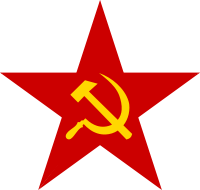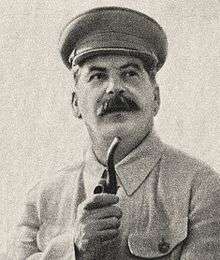Aggravation of class struggle under socialism
The theory of aggravation of the class struggle along with the development of socialism was one of the cornerstones of Stalinism in the internal politics of the Soviet Union. Although the term "class struggle" was introduced by Marx and Engels, and "aggravation of class struggle" was an expression originally coined by Vladimir Lenin in 1919 to refer to the dictatorship of the proletariat,[1] the theory of "class struggle under socialism" was put forward by Joseph Stalin in 1933 and supplied a theoretical base for the claim that ongoing repression of political opponents is necessary. Stalin believed that residual bourgeois elements would persist within the country and that, with support from Western powers, they would try to infiltrate the party. A variation of the theory was also adopted by Mao Zedong in China.
| Part of a series on |
| Communism |
|---|
 |
|
Concepts
|
|
Internationals |
|
Related topics |
|
|
Exposition and origin
Lenin believed that the Civil War (1917–1923) represented the peak of the aggravation of class struggle, which found its representation in the dictatorship of the Soviet regime, and that by war's end, and the victorious establishment of a workers' state in Russia, the bourgeois class was effectively rooted out in Russia and therefore the theory did no longer apply.
Stalin, on the other hand, argued in 1933 that the further the country would move forward in constructing socialism, the more acute forms of struggle will be used by the doomed remnants of exploiter classes in their last desperate efforts - and therefore, political repression was necessary to prevent them from succeeding in their presumed goal of destroying the Soviet Union. Stalin believed that the class enemy could even worm its way into the party claiming to lead a socialist state. He evaluated his associates of the day based on whether they acted on that belief or the belief that a party could have no enemies inside it. Tolerance inside the Party to those who disagreed with the official Party line was called by Stalin "rotten liberalism". He believed such tolerance would make the Party weak and eventually lead to its destruction. As a result, he argued that purges were sometimes necessary.
The notion of the aggravation of class struggle under socialism stands in contrast to the ideas of other communists, such as Nikolai Bukharin or Leon Trotsky, who argued that there was no longer any bourgeoisie in the Soviet Union to have to struggle with, and that the very definition of "socialism" implies there are no longer antagonistic classes in struggle, something Stalin himself noted.[2]
Chinese case
Mao Zedong developed Stalin's idea further, saying that there is the possibility of an entire bourgeoisie developing inside the Communist Party leading a socialist state before the establishment of communism. Mao stressed the supposedly domestic roots of that bourgeoisie, while Stalin focused more on presumed Western spies. According to Mao, the bourgeoisie inside the party aimed at the restoration of capitalism. Mao also held that "peaceful evolution" was the goal of the foreign capitalists, and that the restoration of capitalism could happen from within, without war, if there were an ebb in the class struggle.
Upon the death of Mao, Deng Xiaoping rejected Mao's theory of the "bourgeoisie in the party" and as a result introduced the socialist market economy, justified by the theory of a primary stage of socialism.
See also
References
- ↑ "The main thing that Socialists fail to understand—which constitutes their shortsightedness in matters of theory, their subservience to bourgeois prejudices, and their political betrayal of the proletariat—is that in capitalist society, whenever there is any serious aggravation of the class struggle intrinsic to that society, there can be no alternative but the dictatorship of the bourgeoisie or the dictatorship of the proletariat." Thesis and Report on Bourgeois Democracy and the Dictatorship of the Proletariat § 12 Address to the Comintern, 4 March 1919
- ↑ "Unlike bourgeois constitutions, the draft of the new Constitution of the U.S.S.R. proceeds from the fact that there are no longer any antagonistic classes in society; that society consists of two friendly classes, of workers and peasants; that it is these classes, the labouring classes, that are in power; that the guidance of society by the state (the dictatorship) is in the hands of the working class, the most advanced class in society, that a constitution is needed for the purpose of consolidating a social order desired by, and beneficial to, the working people." The Principal Specific Features of the Draft Constitution § III On the Draft Constitution of the U.S.S.R., 25 November 1936
